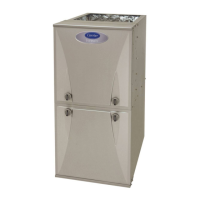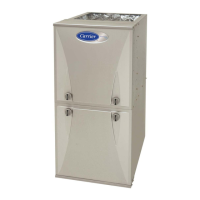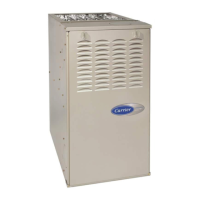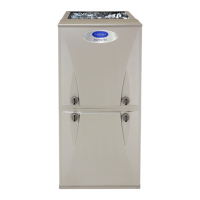1
PG9UAA
Troubleshooting Guide
VARIABLE SPEED, TWO---STAGE
ELECTRONIC CONDENSING
GAS FURNACE
INDEX
PAGE
SAFETY CONSIDERATIONS 1..................................................
INSTRUCTIONS 1............................................................
EXAMPLE 2.................................................................
GENERAL 2.................................................................
SEQUENCE OF OPERATION 2..................................................
Single--Stage Thermostat and Two--Stage Heating (Adaptive Mode) 2...............
Two--Stage Thermostat and Two--Stage Heating 3..............................
Cooling Mode 4........................................................
Single--Speed Cooling 4..................................................
Single--Stage Thermostat and Two--Speed Cooling (Adaptive Mode) 4..............
Two--Stage Thermostat and Two--Speed Cooling 4.............................
Dehumidify Mode 4.....................................................
Super--Dehumidify Mode 5...............................................
Continuous--Blower Mode 5..............................................
Heat Pump Defrost 5....................................................
Component Test 5......................................................
SERVICE/STATUS CODE INSTRUCTIONS 6.......................................
START HERE 8...............................................................
RAPID FLASHING AMBER LED 9...............................................
IMPROPER COOLING AIR FLOW 10.............................................
HIGH HEAT TEMPERATURE RISE TOO LOW 11...................................
STATUS CODE 11 -- NO PREVIOUS CODE 12......................................
STATUS CODE 12 -- BLOWER ON AFTER POWER UP 12............................
STATUS CODE 13 -- LIMIT CIRCUIT LOCKOUT 13.................................
STATUS CODE 14 -- IGNITION LOCKOUT 14......................................
STATUS CODE 15 – BLOWER MOTOR LOCKOUT 14...............................
STATUS CODE 21 -- GAS HEATING LOCKOUT 14..................................
STATUS CODE 22 -- ABNORMAL FLAME--PROVING SIGNAL 15.....................
STATUS CODE 23 -- PRESSURE SWITCH DID NOT OPEN 15.........................
STATUS CODE 24 -- SECONDARY VOLTAGE FUSE IS OPEN 16.......................
STATUS CODE 25 – MODEL SELECTION OR SETUP ERROR 18......................
STATUS CODE 31 – HIGH--HEAT SWITCH OR RELAY DID NOT CLOSE OR REOPEN 18..
STATUS CODE 32 -- LOW--HEAT PRESSURE SWITCH DID NOT CLOSE OR
REOPENED 20...............................................................
STATUS CODE 33 -- LIMIT CIRCUIT FAULT 22....................................
STATUS CODE 34 -- IGNITION--PROVING FAULT 24................................
STATUS CODE 41 – BLOWER MOTOR FAULT 25..................................
STATUS CODE 42 – INDUCER MOTOR FAULT 27..................................
STATUS CODE 43 -- LOW--HEAT PRESSURE SWITCH OPEN WHILE HIGH--HEAT
PRESSURE SWITCH IS CLOSED 29..............................................
STATUS CODE 45 – CONTROL CIRCUITRY LOCKOUT 30...........................
CLEANUP AND START--UP INSTRUCTIONS 30....................................
APPENDIX A -- BOARD LAYOUT & WIRING SCHEMATIC 31........................
APPENDIX B -- ECM BLOWER MOTOR DESCRIPTION & OPERATION 33..............
APPENDIX C -- PRESSURE CHECK DIAGRAM 34..................................
APPENDIX D -- STATIC PRESSURE READING LOCATION DIAGRAMS 35..............
APPENDIX E -- QUICK REFERENCE INFORMATION 36.............................
APPENDIX F -- FURNACE STAGING ALGORITHM 37...............................
SAFETY CONSIDERATIONS
Installing and servicing heating equipment can be hazardous due to
gas and electrical components. Only trained and qualified
personnel should install, repair, or service heating equipment.
Untrained personnel can perform basic maintenance functions such
as cleaning coils, or cleaning and replacing filters. All other
operations should be performed by trained service personnel.
When working on heating equipment, observe precautions in
literature, on tags, and on labels attached to or shipped with the
unit, and other safety precautions that may apply.
Follow all safety codes. In the United States, follow all safety
codes including the National Fuel Gas Code (NFGC) NFPA
54--2009/ANSI Z223.1--2009. In Canada, refer to the National
Standard of Canada Natural Gas and Propane Installation Codes
(NSCNGPIC), CSA B149.1--10.
Wear safety glasses and work gloves. Have a fire extinguisher
available during start--up, adjustment procedures, and service calls.
Recognize safety information. This is the safety--alert symbol
.
When you see this symbol on the furnace and in instructions or
manuals, be alert to the potential for personal injury.
Understand the signal words DANGER, WARNING, and
CAUTION, and NOTE. The words DANGER, WARNING, and
CAUTION are used with the safety--alert symbol. DANGER
identifies the most serious hazards which will result in severe
personal injury or death. WARNING signifies hazards which
could result in personal injury or death. CAUTION is used to
identify unsafe practices which may result in minor personal injury,
or product and property damage. NOTE is used to highlight
suggestions which will result in enhanced installation, reliability, or
operation.
INSTRUCTIONS
This guide uses your expertise and observations to lead you to the
trouble spot as efficiently as possible. This is only intended as a
guide and should not be used blindly. Your experience and
expertise are of high value when troubleshooting this unit. Do not
disregard all of your instincts.
The variable speed furnace control was designed with diagnostic
capabilities built in. An AMBER LED is used to flash a status
code which will lead you to one of the sections as listed in the
Index.
You should ALWAYS begin in the START HERE section (see
Index for page number) which will guide you to the appropriate
section where a minimal number of steps will be used to correct the
problem. Once in a section, read the ACTION. An ACTION may
have a number in the GO TO column. Do whatever the ACTION
says, then proceed to the step indicated in the GO TO column.
If the ACTION is a question (a question will have a number in the
YES or NO column), answer it YES or NO. If the answer is YES,
go to the step indicated in the YES column. If the answer is NO,
go to the step indicated in the NO column.












